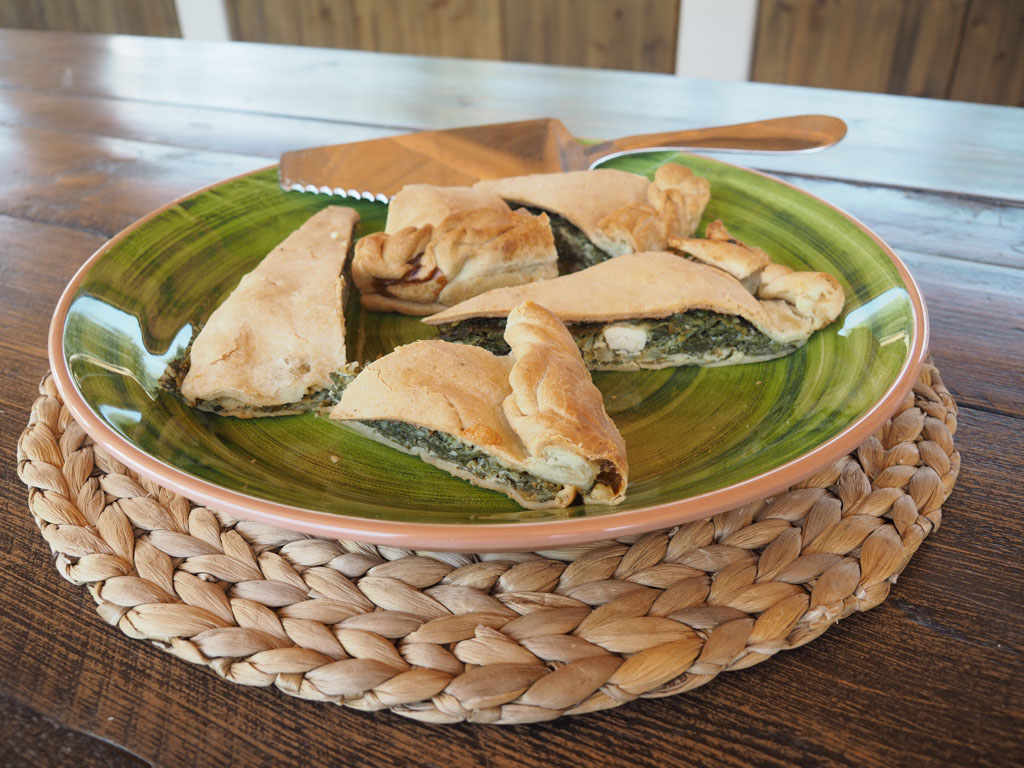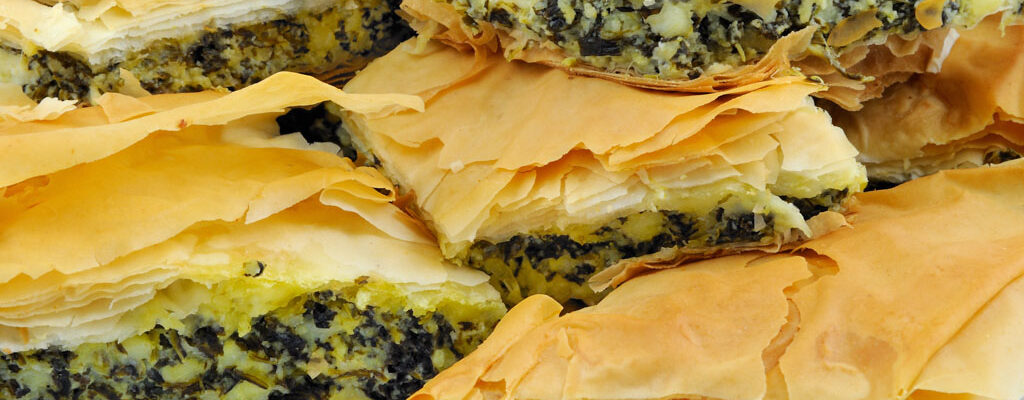Spanakopita, Greece’s beloved spinach and cheese pie, is a delightful mix of crispy layers of golden phyllo dough and a rich, savory filling. The name itself comes from two Greek words: spanaki (σπανάκι), meaning “spinach,” and pita (πίτα), meaning “pie.” Together, they create “Spanakopita” – literally, “spinach pie.” But this dish is so much more than its name suggests. With deep roots in Greek culinary history, Spanakopita has become a symbol of Greek hospitality, flavor, and comfort. Let’s dive into the story of this simple yet much beloved Greek dish, its customs, and even a recipe you can easily try at home!
The Origins of Spanakopita: A Remarkable Taste of Greek Tradition
Spanakopita has a layered history, much like the pie itself. Phyllo pastry and pie-making techniques can be traced back to Byzantine times, but it wasn’t until the Middle Ages—when spinach likely arrived in Greece through Arab traders—that this iconic combination of ingredients came to life. Spinach, native to the Middle East, made its way to Europe through Spain, introduced by Arab traders. During the Byzantine Empire, it reached Greece, where farmers found it easy to cultivate.
Before spinach’s arrival, Greeks, especially in regions like Epirus (mainland Greece), relied on wild greens for their diets. Pies to this day are still very much an integral part of the region’s cuisine and can be found on most if not all restaurant menus. The introduction of spinach provided a new, versatile ingredient that seamlessly integrated into existing culinary traditions. Paired with tangy feta cheese and fresh herbs, it transformed into a dish that embodies the essence of the Mediterranean: simple, wholesome ingredients yielding vibrant flavor.

Beyond flavor, Spanakopita was crafted with practicality in mind. In Greece’s rural regions, where men spent long days working in the fields, this pie became the perfect portable meal. Packed with protein-rich feta, hearty greens, and energy-sustaining phyllo, Spanakopita could withstand the day without spoiling, providing essential nutrition in a compact form. In mountainous areas, Greeks made use of wild greens and locally foraged cheeses, creating filling and nourishing pies from what was readily available.
Thus, Spanakopita grew into more than just a delicious dish; it became a symbol of Greek resilience, resourcefulness, and the beauty of making the most from simple, locally-sourced ingredients.
Customs and Cultural Significance of Spanakopita
In Greece, Spanakopita is more than just a dish—it’s really more of an experience. This pie is enjoyed across Greece as a meze (snack), a side dish, or even as a main meal. It’s a common feature at family gatherings, festive occasions, and church celebrations, symbolizing warmth, family, and abundance. The tradition of sharing Spanakopita is often passed down through generations, with many Greek families having their own “secret” recipe variations. Some families even prepare it in large baking trays for Sunday gatherings, and it’s often offered to guests as a gesture of the famous Greek hospitality – “philoxenia”.

Spanakopita also appears during Greek Easter celebrations, although it’s enjoyed year-round. And if you’re in Greece, you’ll find Spanakopita sold fresh at bakeries each morning – it’s a popular grab-and-go breakfast for locals. And if you want to try something even more authentic, pair it with a Milko (chocolate milk drink) – usually sold in bakeries.
How to Make Authentic Spanakopita at Home: A Simple Recipe
Ingredients
- 1 lb (450g) spinach, chopped and drained
- 1 cup (200g) feta cheese, crumbled
- 1/4 cup ricotta or cottage cheese (optional, for creaminess)
- 2 eggs, beaten
- 1/4 cup fresh dill, chopped
- 1/4 cup fresh parsley, chopped
- Salt and pepper to taste
- 1/2 cup olive oil
- 10-12 sheets phyllo dough (store-bought is fine)
Instructions
- Preheat the Oven: Set your oven to 350°F (180°C). Lightly grease a baking dish with olive oil.
- Prepare the Filling: In a large mixing bowl, combine the spinach, feta, ricotta (if using), eggs, dill, parsley, salt, and pepper. Mix well until all ingredients are evenly combined.
- Layer the Phyllo: Place a sheet of phyllo dough in the baking dish and brush it lightly with olive oil. Repeat with 5-6 sheets, brushing each layer with olive oil.
- Add the Filling: Spread the spinach mixture evenly over the phyllo.
- Top with Phyllo: Layer the remaining sheets of phyllo on top, again brushing each layer with olive oil. Fold any overhanging edges neatly inward.
- Bake: Score the top layer of phyllo into squares with a sharp knife. Bake for 30-40 minutes or until the top is golden brown and crispy.
- Serve and Enjoy: Let the Spanakopita cool slightly before cutting. Serve warm or at room temperature.
Enjoy A Slice of Greece, Anywhere in the World

Spanakopita is a dish that connects people with Greece’s vibrant culinary history. It’s a simple, satisfying pie that reminds us of the simple joy found in sharing food with family and friends. Whether you’re a seasoned cook or new to Greek cuisine, this recipe is a wonderful way to bring a taste of Greece to your table. So gather your ingredients, warm up your oven, and get ready to experience the rich flavors of Spanakopita. “Καλή όρεξη” (kalí órexi)!

